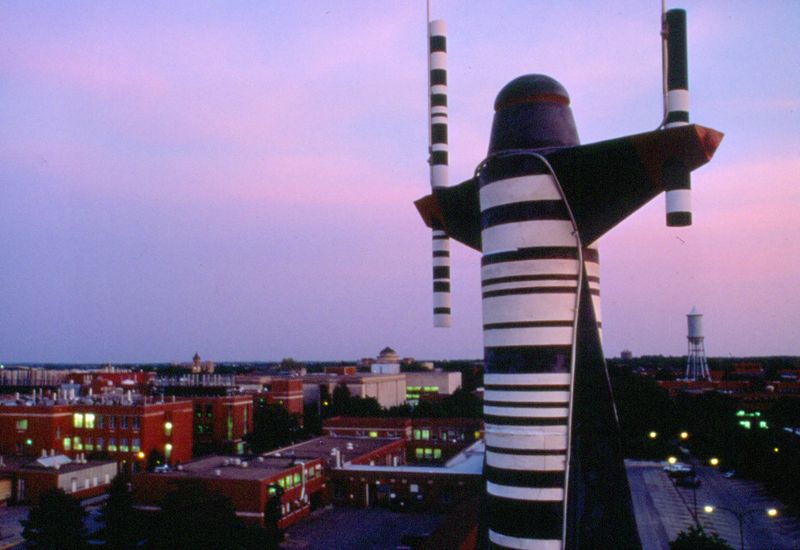
About the Art
Artist Andrew Leicester installed his G-Nome Project in the Molecular Biology Building (MBB) in 1991. The sculpture G-Nomes is four 12-foot-tall terra-cotta roof guards individually standing on the four roof corners of the building.
When Leicester was commissioned by Iowa State University to create this public art, he began to research the kinds of activities that would take place in the new building by attending lectures, reading books, and having conversations with scientists and students. Being selected at the start of the building plan allowed him to incorporate art into the building’s design with the architectural firm, Hansen Lind Meyer, Inc.
The G-Nomes roof guards serve as “sacred guardians” of MBB. Stretching up and down each side of the building beneath G-Nomes is a pattern of ceramic tiles in a twisting style to portray strands of DNA (Deoxyribonucleic acid). Strands of DNA hold the secrets of life inside the human body and the stylistic choices on the outside of the building references the MBB’s teaching and research to uncover the secrets to life.
Each g-nome figure holds X and Y chromosome rods. The choice to use black and white in the sculptures is a symbolic reference to the black suits worn by businesspeople and the white lab coats worn by scientists. These two professions are necessary to the Molecular Biology Program at Iowa State University. Black and white squares of the G-Nome Project, including G-Nomes, suggest crossword puzzles and the challenge of solving games. Molecular biologists within the MBB are trying to solve the genetic code of life.
In 2017 the original four terra-cotta G-Nomes began d to deteriorate due to the elements. With permission from Andrew Leicester the replacements were fabricated in aluminum by the Public Arts Incubator at the University of Northern Iowa so the entire G-Nome Project could last forever.
About the Artist
Andrew Leicester was born in 1948 in England and emigrated to the United States in 1970 where he still lives and works. He has created over 15 major permanent public art works across the US including the Minnesota Highway Project (1974), Texas-Floating, Mesa (1980-81), and South Dakota-Toth (1983). Leicester is recognized for his large outdoor sculptures and projects that range in size and scope from small courtyards and amphitheaters on campuses to municipal plazas, park entrances, and water gardens. Leicester has received multiple awards for his work as well as fellowships from the Bush Foundation, the McKnight Foundation, and the National Endowment for the Arts.
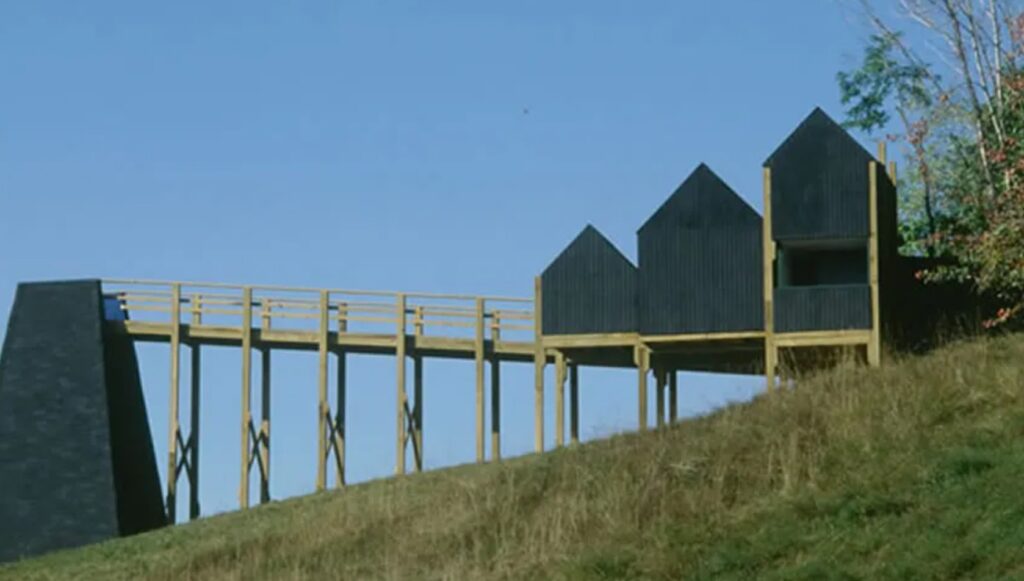
Prospect V-III, Frostburg, Maryland

Floating Mesa, 1980-81, Goat Mountain, Amarillo, Texas

Cincinnati Gateway, 1988, Cincinnati, Ohio
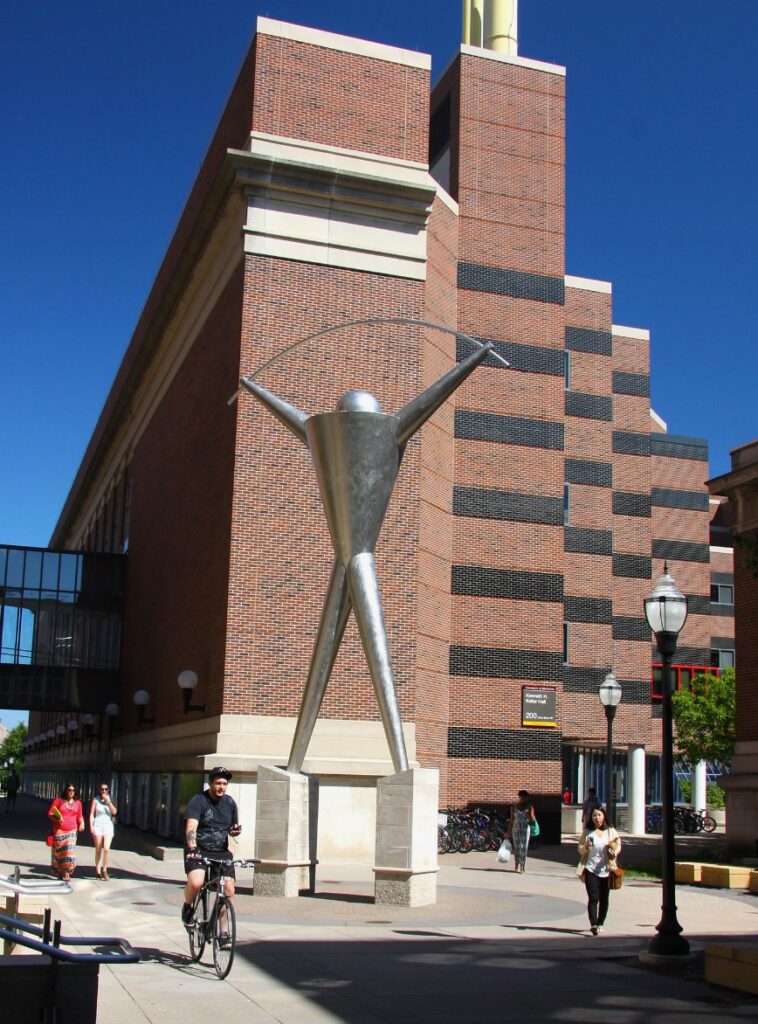
Platonic Figure, 2001, University of Minnesota, Minnesota
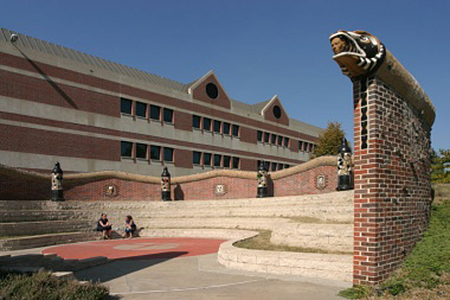
Castle of Perseverance, University of Nebraska, Omaha, Nebraska
Relevant Terminology/History
Due to the everchanging research on genomes and molecular biology, the material for this section has come from the National Human Genome Research Institute as of September 2023.
The genome is the entire set of DNA instructions found in a cell. In humans, the genome consists of 23 pairs of chromosomes located in the cell’s nucleus, as well as a small chromosome in the cell’s mitochondria. A genome contains all the information needed for an individual to develop and function.
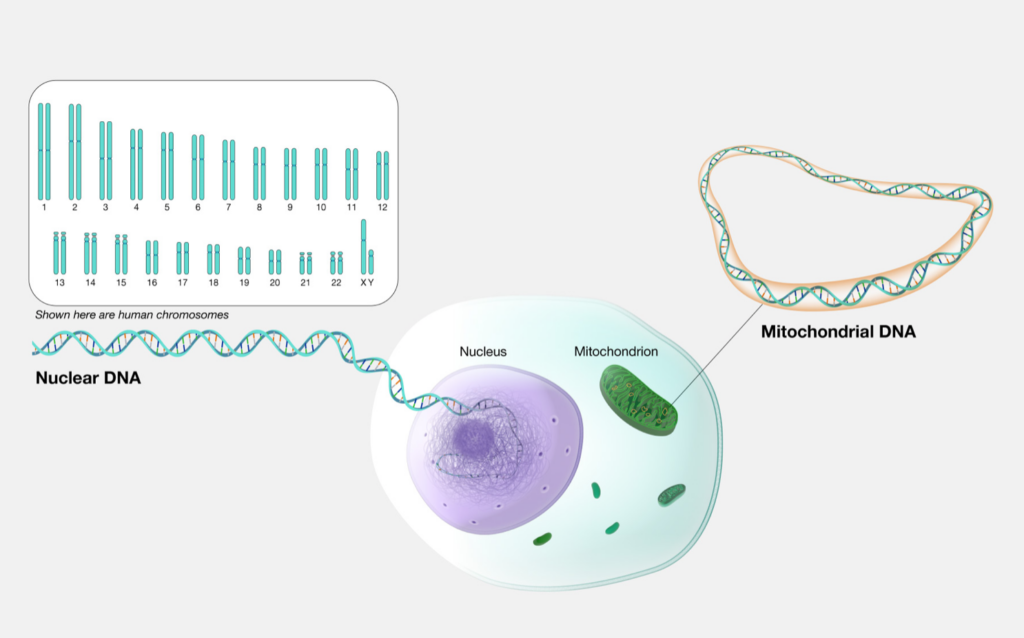
Genome image, courtesy of the National Human Genome Research Institute.
The Human Genome Project was an international scientific research project with the goal of determining the base pairs that make up human DNA, and of identifying, mapping, and sequencing all the genes of the human genome from both a physical and a functional standpoint. The Human Genome Project was started in October 1990, and then reported the sequence of the human genome in April 2003. The initial “finished” sequence was missing 8% of the genome (mostly repetitive sequences). With advancements in technology that could handle sequencing of the many repetitive sequences found in human DNA that were not fully uncovered by the original Human Genome Project study, scientists reported the first end-to-end human genome sequence in March 2022.
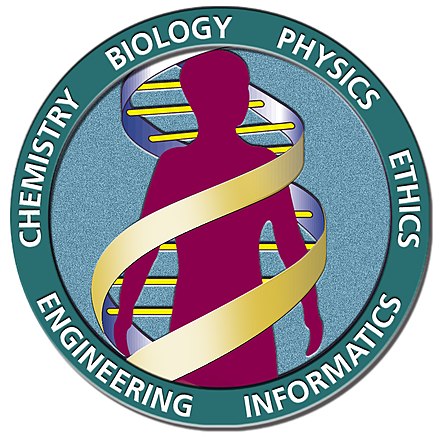
Logo of the Human Genome Project, courtesy of Wikipedia.
Molecular biology is the study of the biochemical and molecular processes within cells, especially the processes of DNA replication, RNA transcription, and protein translation.
Chromosomes are a threadlike structure of nucleic acids and protein found in the nucleus of most living cells, carrying genetic information in the form of genes.

Image of chromosome from the University of Pittsburgh.

Y and X chromosomes, image courtesy of National Human Genome Research Institute.
A telomere is a region of repetitive DNA sequences at the end of a chromosome. Telomeres protect the ends of chromosomes from becoming frayed or tangled. Each time a cell divides, the telomeres become slightly shorter. Eventually, they become so short that the cell can no longer divide successfully, and the cell dies.
DNA (Deoxyribonucleic acid) is the molecule that carries genetic information for the development and functioning of an organism. DNA is made of two linked strands that wind around each other to resemble a twisted ladder, the double helix.

Diagram of DNA, courtesy of Wikipedia.
The Nobel Prize in Physiology or Medicine in 1962 was awarded to James Watson, Francis Crick and Maurice Wilkins for their discovery of the molecular structure of DNA. Their discoveries helped “solve one of the most important of all biological riddles” according to the Nobel Prize committee. Rosalind Franklin was a part of this team, but she died of cancer at 37 and was then ineligible for the award.
RNA (Ribonucleic acid) is a nucleic acid present in all living cells. RNA is often single-stranded. An RNA molecule has a backbone made of alternating phosphate groups and the sugar ribose, rather than the deoxyribose found in DNA. Attached to each sugar is one of four bases: adenine (A); uracil (U); cytosine (C); or guanine (G).
The Messenger RNA (mRNA) vaccine gives your cells instructions for how to make the “S” protein found on the surface of the COVID-19 virus. After you receive the vaccination, your muscle cells begin making the “S” protein pieces and displaying them on cell surfaces. This causes your body to create antibodies. If you become infected with the COVID-19 virus, the antibodies will fight the virus. Once the protein pieces are made the cells break down the instructions and get rid of the virus. The Pfizer-BioNTech and the Moderna COVID-19 vaccines use mRNA.
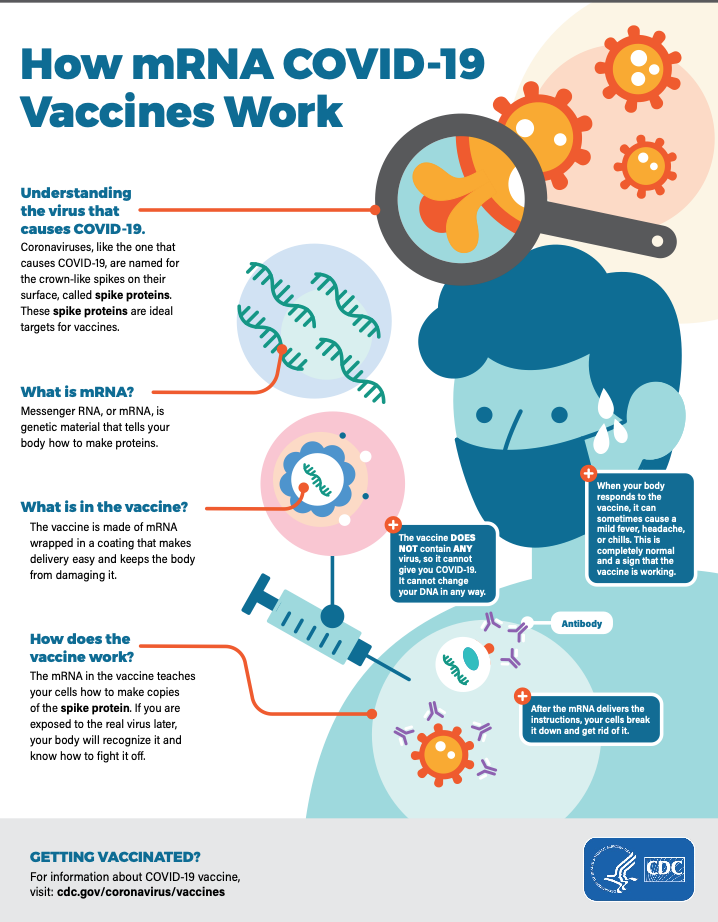
Infographic courtesy of the Center for Disease Control.
Luke Jerram’s Covid19 is a glass sculpture of the Covid-19 virus.
The Molecular, Cellular & Developmental Biology Interdepartmental Graduate Program at Iowa State University is a multidisciplinary major that allows students to explore the mechanisms of life processes in cutting-edge research labs. ISU students perform independent research under the guidance of top faculty investigating a diverse range of questions in the sciences of molecular, cellular, and developmental biology.
Norie Sato’s e+l+e+m+e+n+t+a+l includes a blown glass statue of a g-nome.
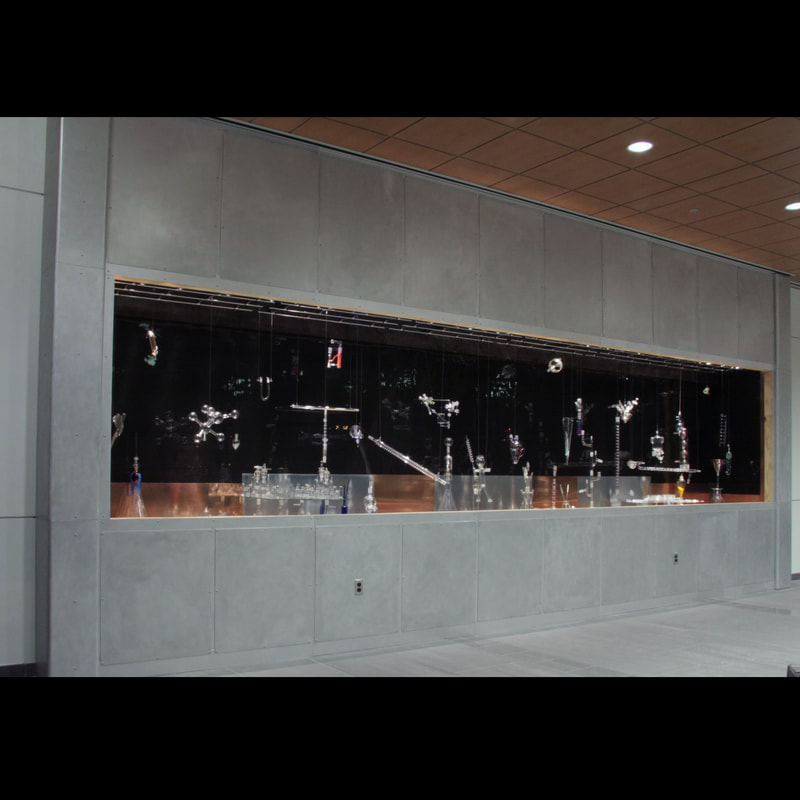
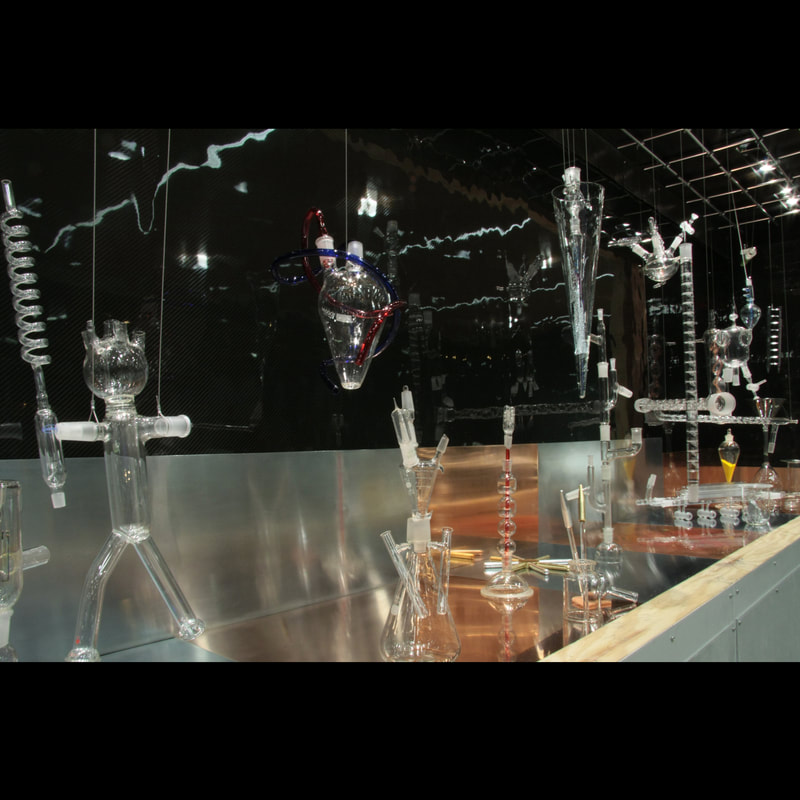
A gnome, from the Renaissance Latin word gnomus, is a mythological creature and diminutive spirit in Renaissance magic and alchemy. Gnomes were introduced by Paracelsus in the 16th century from his book, A Book on Nymphs, Sylphs, Pygmies, and Salamanders, and on the Other Spirits published posthumously in 1566 (in the town Nysa, Poland). Gnomes were widely adopted by authors including those of modern fantasy literature. Authors of Romanticist collections of fairy tales are known to include gnomes as they have become mostly synonymous with goblin. Usually represented as small humanoids who live underground, gnome characteristics are reinterpreted to suit various storytellers and artists. Lawn ornaments crafted as gnomes were introduced during the 19th century, growing in popularity during the 20th century as garden gnomes.
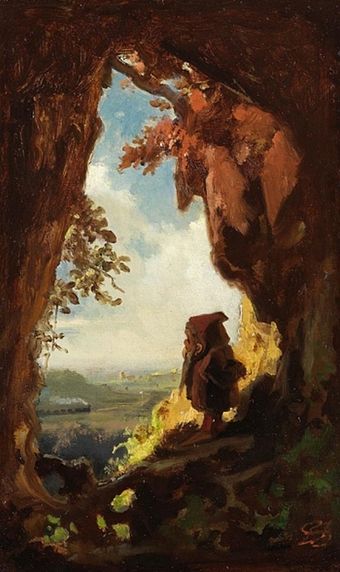
Gnome Watching Railway Train, Carl Spitzweg, 1848, private collection, image courtesy of Wikipedia.
Garden Gnomes are lawn ornament figurines of small humanoid creatures based on the mythological creature and diminutive spirit which occur in Renaissance magic and alchemy, known as gnomes. They draw on the German folklore of the dwarf. The garden figurines are traditionally depicted as male dwarfs wearing red pointy hats. Originating as a decoration for the wealthy in Europe, garden gnomes are now prevalent in gardens and lawns throughout the Western world, among all social classes. They are regarded by some as kitsch.
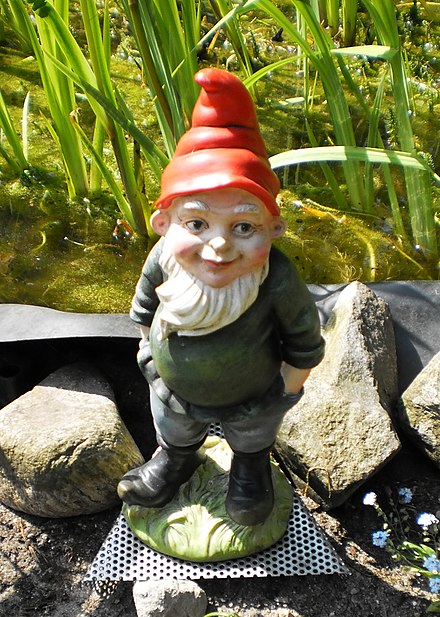
German garden gnome, courtesy of Wikipedia.
*Fun Fact: Wroclaw, Poland is famous for its 600+ gnomes “hidden” throughout the city. They were originally placed around the city to oppose Communism in a humorous and satirical manner. Wooden.City, located in Wroclaw and staffed with Ukrainians who fled Crimea, manufactured Dr. Klemm’s Number Linx puzzle. Below are images of Wroclaw gnomes taken by Dr. Klemm during a visit in 2022.
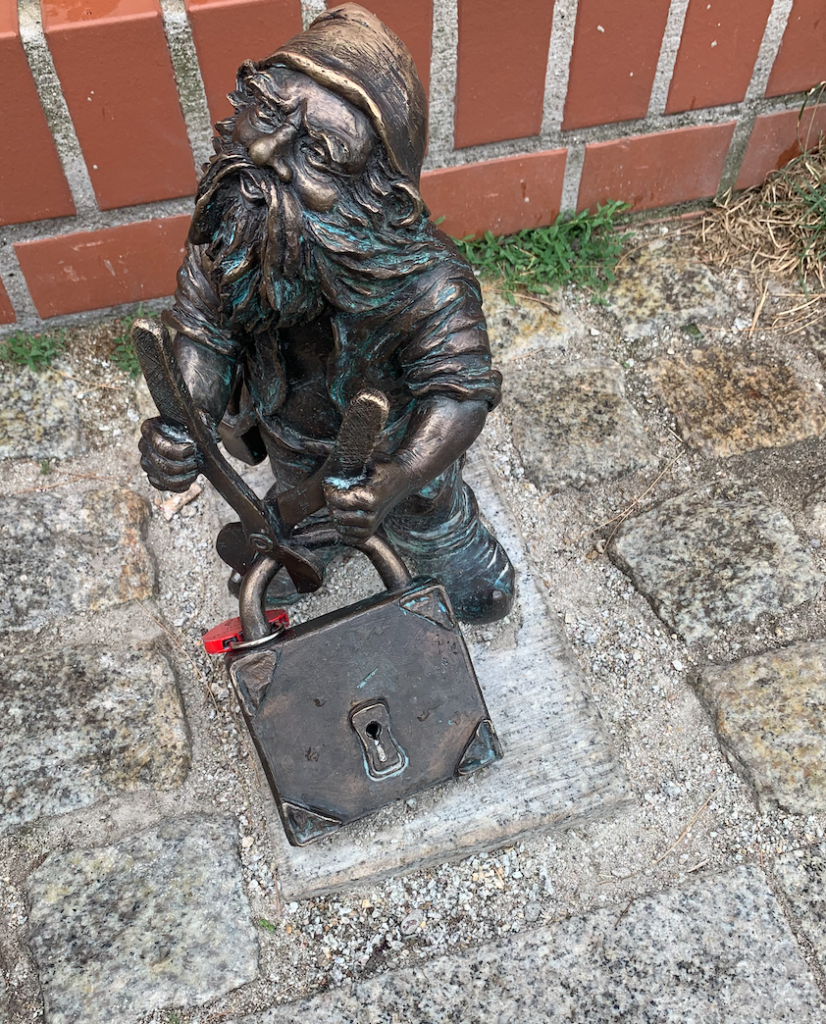
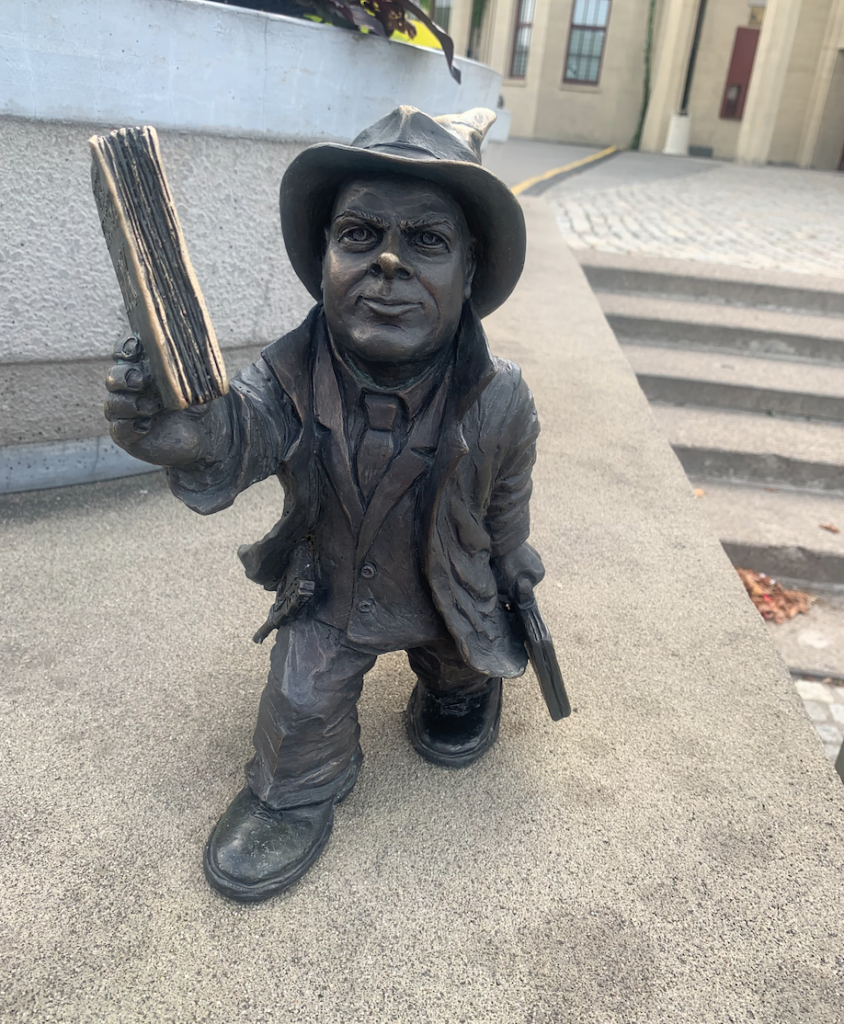
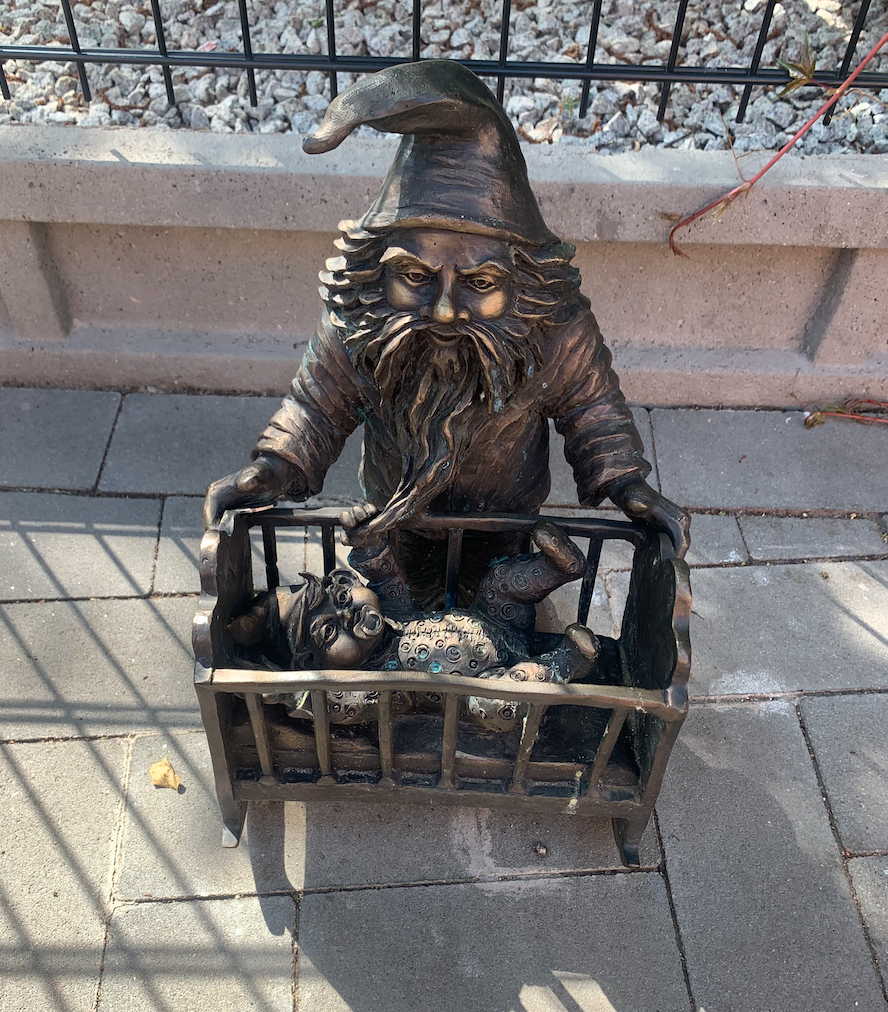
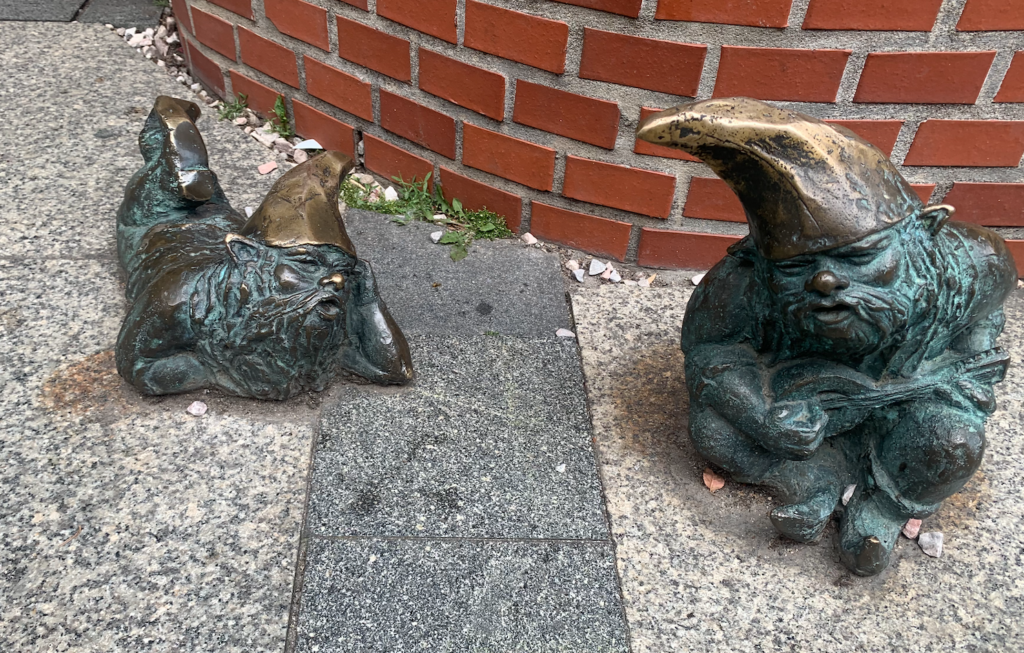
Pictures courtesy of Dr. Klemm on her trip to Wroclaw, Poland in July 2022.
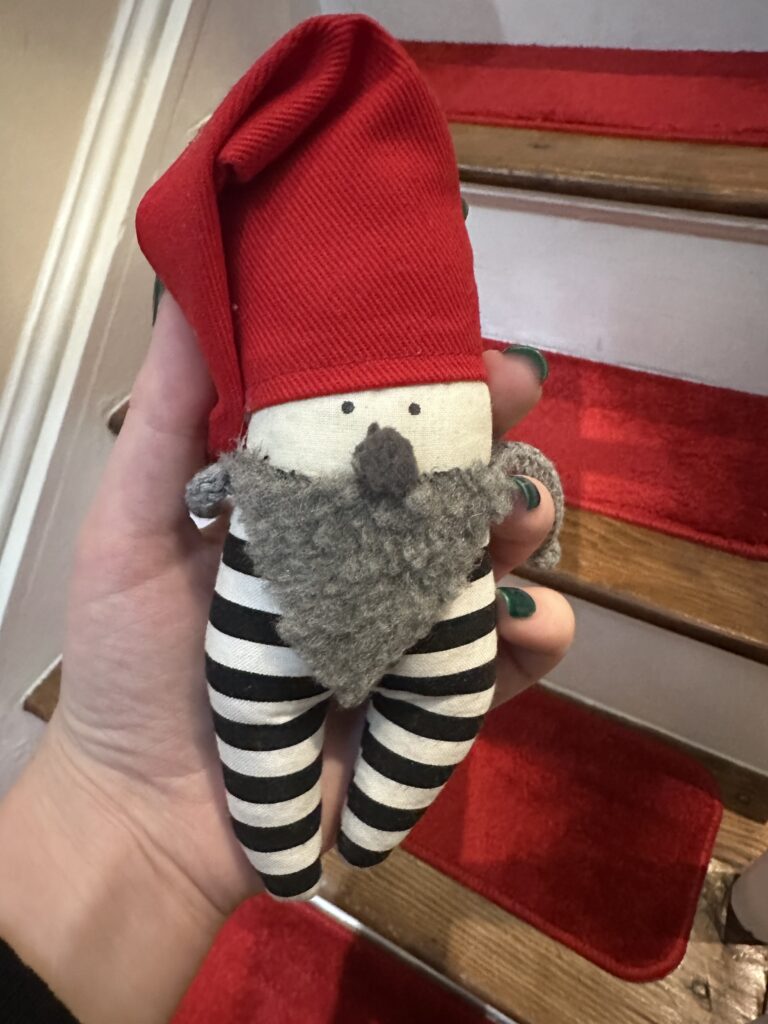
Souvenir gnome from Dr. Klemm’s trip to Wroclaw, Poland.
Learning Guide
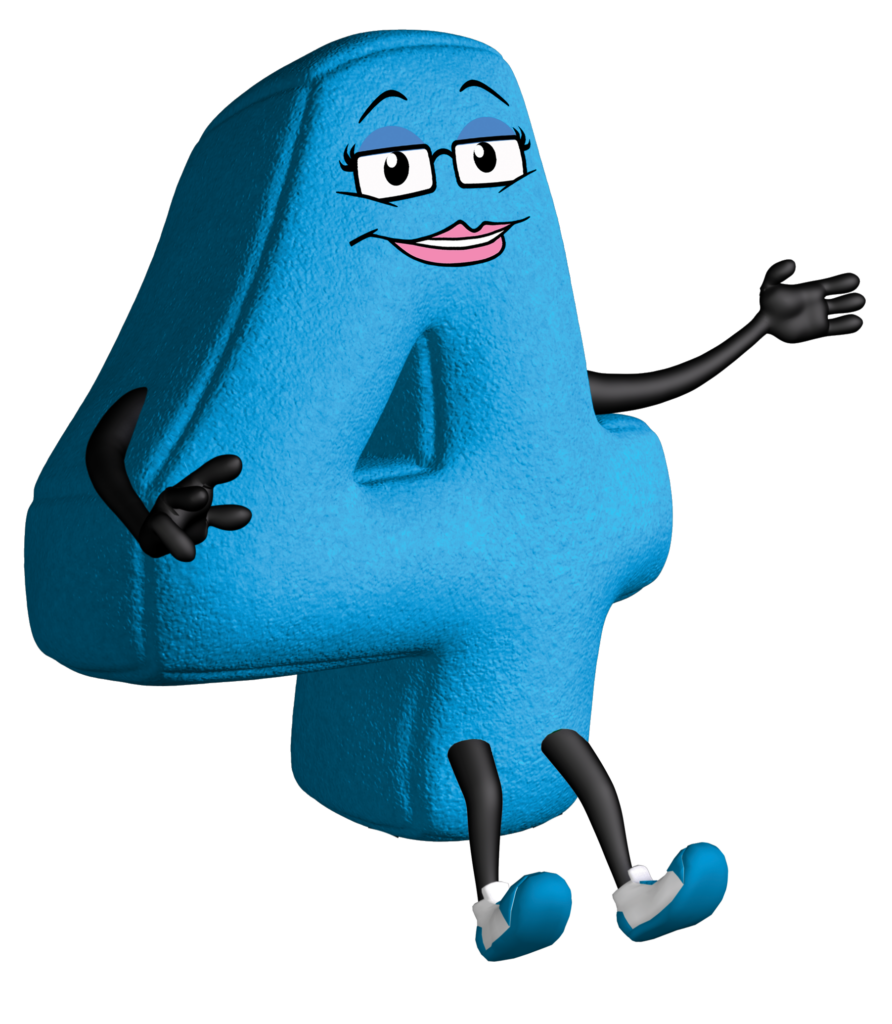
- What do think the title has to do with the art?
- Why do you think Number Character 4 is speaking about the art?
- How does the red image with white numbers relate to the art? Can you find the shape in the art?
- How does the hidden blue image relate to the art?
- What is the difference between G-Nome Project and G-Nomes?
- Leicester created the word “g-nome” from what two words?
- What are the rods that each g-nome is holding? How do they differ?
- Why do you think Leicester created G-Nomes using only black and white?
- Do you know how many X and Y chromosomes you have?
- Why are James Watson, Francis Crick, and Maurice Wilkins famous?
- Who was Rosalind Franklin? Why was she not listed as part of the team who received the Nobel Prize in Physiology or Medicine?
- What is the difference between DNA and RNA?
- What was new about the vaccine approach to Covid-19 created by Moderna and Pfizer?
- Which stories do you like that include gnomes? Why?
- Do you have a gnome in your garden or your house?
